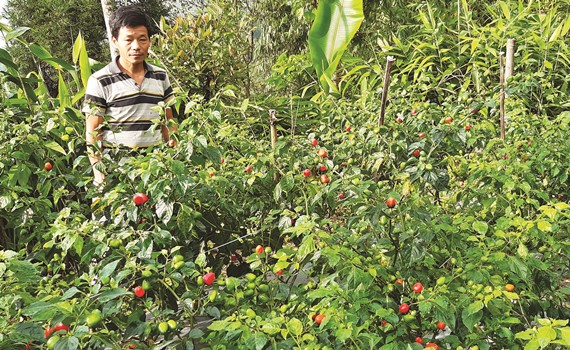Ilam farmers unable to meet demand of Akabare chillis

By Kokila Dhakal
Ilam Dec. 15: Demand for Akabare chilli, which has become a reliable source of income for farmers here, is now high in the market. Demand for Akabare chilli generally goes up after the weather gets colder.
However, farmers have said that the demand was high due to the decline in its production after a disease destroyed the plants of this indigenous chilli. This year, Akabare chilli is being sold at Rs. 480 to Rs. 500 per kg from the farmers' houses.
Madan Rai, a farmer of Suryodaya Municipality-12, has sold Akabare chilli at the rate of Rs. 600 per kg this year. The demand for Akabare chilli produced by Rai, who has been farming Akabare chilli commercially for the past seven years, is high in the local market as well as abroad.
Rai informed that he had sent 200 kg chilli to Hong Kong this year. "Nepalis living in India, the United States, Saudi Arabia, Qatar, Malaysia and Hong Kong have been demanding Akabare from Ilam," he said. “We cannot supply the product as demanded.”
The demand for Rai’s chilli is high as they are organic. Rai, who has planted 10,000 Akbare plants, is still picking the chilli though it is already mid-December. Rai has already sold 300 kg of Akabare chilli this year, but has been unable to supply chilli as per the demand of various spice and noodle industries.
Rai is also receiving demand for seeds of Akabare chilli. Rai said that he had sold 7 kg of seed at the rate of Rs. 25,000 per kg last year and he was preparing seeds this year as well.
Rai said that the production of chilli in his farm was good as the disease did not appear in his farm when the farms of others were damaged by pests. Rai applies a slightly different technique to plant Akabare chilli. Rai has been cultivating Akabare inside the plastic tunnel. He said that the production would be better if it could be protected from fog.
Rai has been using cow dung and urine, dust of bones and self-produced compost manure in his farm. According to Rai, the buttermilk (mohi) made by extracting ghee from curd is also used in a certain way to protect the crops from diseases.
Tika Chapagain, a farmer of Maijogmai Rural Municipality-5, Soyang, said that Akabare chilli farming has been very fruitful for her after its price went up.
Chapagain, who has planted only 600 plants, said that she was selling more than 5 kg of chillies per week. "The household expenses and stationeries and school uniform for the children have been met from the income made from chilli,” said Chapagain. "The price is better this year than last year and chillies are being sold from home."
Suryadaya Municipality has sent technicians to the farmers to check the soil and diseases after Akabare chilli farmers suffered heavy losses due to the disease this year. Narayan Lamsal, chief of the agriculture department of the municipality, urged the farmers to be aware of the recurrence of the diseases. Lamsal has advised to uproot the diseased plant and burn it.
Farmers of Panchakanya, Soyang, Namsaling, Sumbek, Sulubung, Maimzhuwa, Godak, Kanyam, Laxmipur and other villages of the district have been cultivating Akabare chilli commercially. According to the Agriculture Knowledge Centre, Ilam, Akabare is cultivated in 155 hectares of land in the district.
Chillis produced in Ilam is regarded to be the second hottest in the world after those produced in Assam, India.
Recent News

Do not make expressions casting dout on election: EC
14 Apr, 2022
CM Bhatta says may New Year 2079 BS inspire positive thinking
14 Apr, 2022
Three new cases, 44 recoveries in 24 hours
14 Apr, 2022
689 climbers of 84 teams so far acquire permits for climbing various peaks this spring season
14 Apr, 2022
How the rising cost of living crisis is impacting Nepal
14 Apr, 2022
US military confirms an interstellar meteor collided with Earth
14 Apr, 2022
Valneva Covid vaccine approved for use in UK
14 Apr, 2022
Chair Prachanda highlights need of unity among Maoist, Communist forces
14 Apr, 2022
Ranbir Kapoor and Alia Bhatt: Bollywood toasts star couple on wedding
14 Apr, 2022
President Bhandari confers decorations (Photo Feature)
14 Apr, 2022










